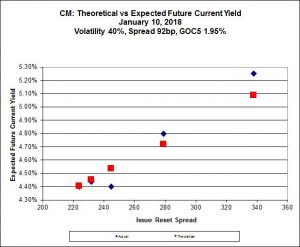Canadian Imperial Bank of Commerce has announced:
that it had entered into an agreement with a group of underwriters led by CIBC Capital Markets for an issue of 16 million Basel III-compliant Non-cumulative Rate Reset Class A Preferred Shares Series 47 (Non-Viability Contingent Capital (NVCC)) (the “Series 47 Shares”) priced at $25.00 per Series 47 Share to raise gross proceeds of $400 million.
CIBC has granted the underwriters an option to purchase up to an additional two million Series 47 Shares at the same offering price, exercisable at any time up to two days prior to closing. Should the underwriters’ option be fully exercised, the total gross proceeds of the financing will be $450 million.
The Series 47 Shares will yield 4.5% per annum, payable quarterly, as and when declared by the Board of Directors of CIBC, for an initial period ending January 31, 2023. On January 31, 2023, and on January 31 every five years thereafter, the dividend rate will reset to be equal to the then current five-year Government of Canada bond yield plus 2.45%.
Subject to regulatory approval and certain provisions of the Series 47 Shares, on January 31, 2023 and on January 31 every five years thereafter, CIBC may, at its option, redeem all or any part of the then outstanding Series 47 Shares at par.
Subject to the right of redemption, holders of the Series 47 Shares will have the right to convert their shares into Non-cumulative Floating Rate Class A Preferred Shares Series 48 (Non-Viability Contingent Capital (NVCC)) (the “Series 48 Shares”), subject to certain conditions, on January 31, 2023 and on January 31 every five years thereafter. Holders of the Series 48 Shares will be entitled to receive a quarterly floating rate dividend, as and when declared by the Board of Directors of CIBC, equal to the three-month Government of Canada Treasury Bill yield plus 2.45%.
Holders of the Series 48 Shares may convert their Series 48 Shares into Series 47 Shares, subject to certain conditions, on January 31, 2028 and on January 31 every five years thereafter.
The expected closing date is January 18, 2018. CIBC will make an application to list the Series 47 Shares as of the closing date on the Toronto Stock Exchange. The net proceeds of this offering will be used for general purposes of CIBC.
This issue looks quite expensive to me, according to Implied Volatility Analysis:
We see in this chart many of the same features we saw when reviewing the recent BPO new issue and yesterday’s BEP issue:
- The curve is very steep, with Implied Volatility equal to 40% (a ridiculously large figure), and
- The extant issues ar trading near par
The ludicrously high figure of Implied Volatility is something I take to mean that the underlying assumption of the Black-Scholes model, that of no directionality of prices, is not accepted by the market; the market seems to be taking the view that since things seem rosy now, they will always be rosy and everything will trade near par in the future.
I balk at ascribing a 100% probability to this outcome. There may still be a few old geezers amongst the Assiduous Readers of this blog who can still (faintly) remember the Great Bear Market of 2014-16, in which quite a few similar assumptions made earlier turned out to be slightly inaccurate.
For the long term, I suggest that any change in the slope of the curve will be a flattening, with a very high degree of confidence. This will imply that the higher-spread issues will outperform the lower-spread issues.
All told, though, I have no hesitation in slapping an ‘Expensive’ label on this issue – according to the Implied Volatility analysis shown above, the theoretical price of the new issue is 24.26.







